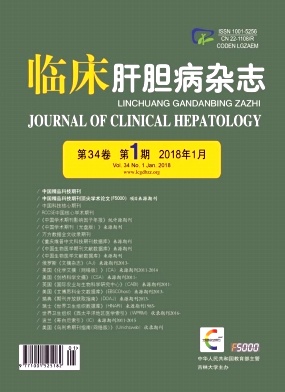|
[1]VENOOK AP, PAPANDREOU C, FURUSE J, et al.The incidence and epidemiology of hepatocellular carcinoma:a global and regional perspective[J].Oncologist, 2010, 15 Suppl 4:5-13.
|
|
[2]GATENBY RA.A change of strategy in the war on cancer[J].Nature, 2009, 459 (7246) :508-509.
|
|
[3]LI Y, ZHANG Z, SHI J, et al.Risk factors for naturally-occurring early-onset hepatocellular carcinoma in patients with HBVassociated liver cirrhosis in China[J].Int J Clin Exp Med, 2015, 8 (1) :1205-1212.
|
|
[4]KEW MC.The role of cirrhosis in the etiology of hepatocellular carcinoma[J].J Gastrointest Cancer, 2014, 45 (1) :12-21.
|
|
[5]JIAO JZ, LI JT, YAN SG, et al.Current research status of precancerous dysplastic nodules in hepatocellular carcinoma[J].J Clin Hepatol, 2017, 33 (5) :974-978. (in Chinese) 焦俊喆, 李京涛, 闫曙光, 等.肝细胞癌癌前异型增生结节的研究现状[J].临床肝胆病杂志, 2017, 33 (5) :974-978.
|
|
[6]ZHANG L, ZHOU F, TEN DIJKE P.Signaling interplay between transforming growth factor-βreceptor and PI3K/AKT pathways in cancer[J].Trends Biochem Sci, 2013, 38 (12) :612-620.
|
|
[7]ZHOU Q, LUI VW, YEO W.Targeting the PI3K/Akt/m TOR pathway in hepatocellular carcinoma[J].Future Oncol, 2011, 7 (10) :1149-1167.
|
|
[8]MORMONE E, GEORGE J, NIETO N.Molecular pathogenesis of hepatic fibrosis and current therapeutic approaches[J].Chem Biol Interact, 2011, 193 (3) :225-231.
|
|
[9]WHITTAKER S, MARAIS R, ZHU AX.The role of signaling pathways in the development and treatment of hepatocellular carcinoma[J].Oncogene, 2010, 29 (36) :4989-5005.
|
|
[10]COULOUARN C, CORLU A, GLAISE D, et al.Hepatocyte-stellate cell cross-talk in the liver engenders a permissive inflammatory microenvironment that drives progression in hepatocellular carcinoma[J].Cancer Res, 2012, 72 (10) :2533-2542.
|
|
[11]SANTAMATO A, FRANSVEA E, DITURI F, et al.Hepatic stellate cells stimulate HCC cell migration via laminin-5 production[J].Clin Sci (Lond) , 2011, 121 (4) :159-168.
|
|
[12]HERNANDEZ-GEA V, TOFFANIN S, FRIEDMAN SL, et al.Role of the microenvironment in the pathogenesis and treatment of hepatocellular carcinoma[J].Gastroenterology, 2013, 144 (3) :512-527.
|
|
[13]THOMPSON AI, CONROY KP, HENDERSON NC.Hepatic stellate cells:central modulators of hepatic carcinogenesis[J].BMC Gastroenterol, 2015, 15:63.
|
|
[14]SONG Y, KIM SH, KIM KM, et al.Activated hepatic stellate cells play pivotal roles in hepatocellular carcinoma cell chemoresistance and migration in multicellular tumor spheroids[J].Sci Rep, 2016, 6:36750.
|
|
[15]WANG X, HASSAN W, JABEEN Q, et al.Interdependent and independent multidimensional role of tumor microenvironment on hepatocellular carcinoma[J].Cytokine, 2017.[Epub ahead of print]
|
|
[16]TAHMASEBI BIRGANI M, CARLONI V.Tumor microenvironment, a paradigm in hepatocellular carcinoma progression and therapy[J].Int J Mol Sci, 2017, 18 (2) :405.
|
|
[17]XIA YH, LU Z, ZHAO M, et al.Tumor-specific hepatic stellate cells (t HSCs) induces DIgR2 expression in dendritic cells to inhibit T cells[J].Oncotarget, 2017, 8 (33) :55084-55093.
|
|
[18]WU K, DING J, CHEN C, et al.Hepatic transforming growth factor beta gives rise to tumor-initiating cells and promotes liver cancer development[J].Hepatology, 2012, 56 (6) :2255-2267.
|
|
[19]KATZ LH, LI Y, CHEN JS, et al.Targeting TGF-βsignaling in cancer[J].Expert Opin Ther Targets, 2013, 17 (7) :743-760.
|
|
[20]GUPTA DK, SINGH N, SAHU DK.TGF-βmediated crosstalk between malignant hepatocyte and tumor microenvironment in hepatocellular carcinoma[J].Cancer Growth Metastasis, 2014, 7:1-8.
|
|
[21]YOSHIDA K, MURATA M, YAMAGUCHI T, et al.Reversible human TGF-βsignal shifting between tumor suppression and fibro-carcinogenesis:implications of smad phospho-isoforms for hepatic epithelial-mesenchymal transitions[J].J Clin Med, 2016, 5 (1) .pii:E7.
|
|
[22]ZHU HB, YANG YS, GUO MZ.Transforming growth factorβ (TGF-β) and hepatocellular carcinoma[J].Chin J Gastroenterol Hepatol, 2012, 21 (3) :206-209. (in Chinese) 朱宏斌, 杨云生, 郭明洲.肝癌中转化生长因子 (TGF) -β信号转导通路的研究进展[J].胃肠病学和肝病学杂志, 2012, 21 (3) :206-209.
|
|
[23]COULOUARN C, CLEMENT B.Stellate cells and the development of liver cancer:therapeutic potential of targeting the stroma[J].J Hepatol, 2014, 60 (6) :1306-1309.
|
|
[24]YOSHIDA K, MURATA M, YAMAGUCHI T, et al.TGF-β/Smad signaling during hepatic fibro-carcinogenesis (review) [J].Int J Oncol, 2014, 45 (4) :1363-1371.
|
|
[25]ARRESE M, CABRERA D, HERNANDEZ A, et al.TGF-βand hepatocellular carcinoma:when a friend becomes an enemy[J].Curr Protein Pept Sci, 2017.[Epub ahead of print]
|
|
[26]ZHANG YE.Non-Smad pathways in TGF-beta signaling[J].Cell Res, 2009, 19 (1) :128-139.
|
|
[27]SPANGLE JM, ROBERTS TM, ZHAO JJ.The emerging role of PI3K/AKT-mediated epigenetic regulation in cancer[J].Biochim Biophys Acta, 2017, 1868 (1) :123-131.
|
|
[28]JOSHI S, SINGH AR, DURDEN DL.Pan-PI-3 kinase inhibitor SF1126 shows antitumor and antiangiogenic activity in renal cell carcinoma[J].Cancer Chemother Pharmacol, 2015, 75 (3) :595-608.
|
|
[29]SINGH AR, JOSHI S, BURGOYNE AM, et al.Single agent and synergistic activity of the"first-in-class"dual PI3K/BRD4 inhibitor SF1126 with sorafenib in hepatocellular carcinoma[J].Mol Cancer Ther, 2016, 15 (11) :2553-2562.
|
|
[30]GULHATI P, BOWEN KA, LIU J, et al.m TORC1 and m TORC2 regulate EMT, motility, and metastasis of colorectal cancer via Rho A and Rac1 signaling pathways[J].Cancer Res, 2011, 71 (9) :3246-3256.
|







 DownLoad:
DownLoad: